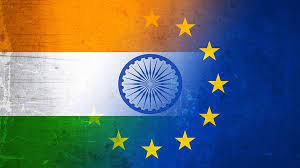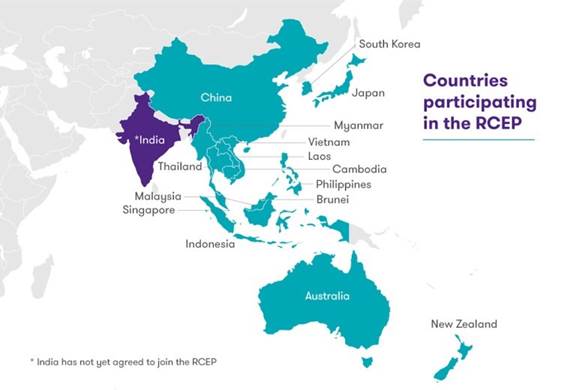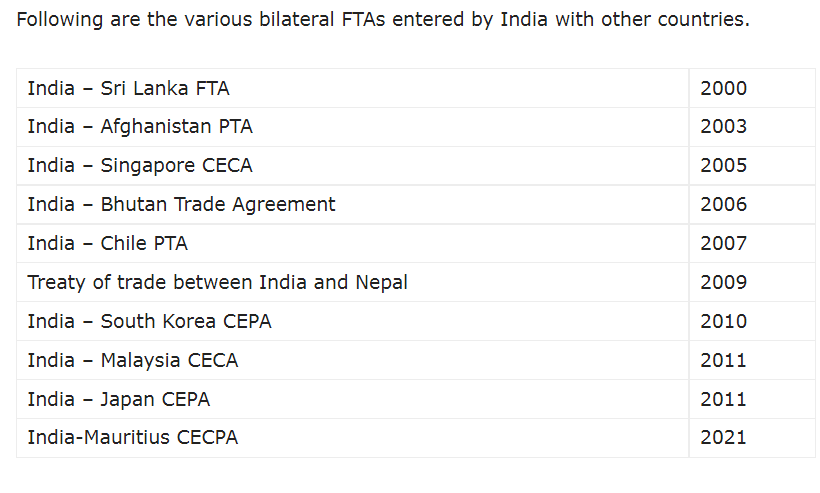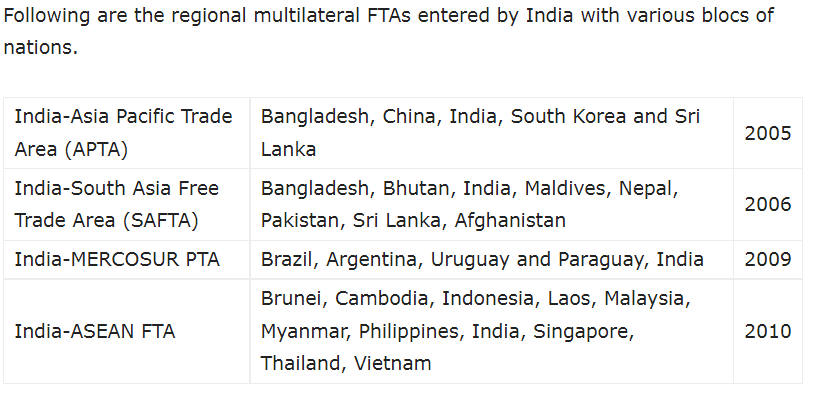
Disclaimer: Copyright infringement not intended.
Context: In a joint event held at the Headquarters of the European Union (EU) at Brussels, Union Minister for Commerce and Industry and Executive Vice-President of European Commission formally re-launched the India-EU Free Trade Agreement (FTA) negotiations. Besides, negotiations were also launched for a stand-alone Investment Protection Agreement (IPA) and a Geographical Indicators (GIs) Agreement.
More on the news:
- Last year, in the India and EU Leaders’ Meeting held in Porto on 8th May 2021, an agreement was reached for resuming negotiations for a balanced, ambitious, comprehensive and mutually beneficial FTA and starting fresh negotiations on the IPA and a separate agreement on GIs.
- Both partners are now resuming the FTA talks after a gap of about nine years since the earlier negotiations were left off in 2013 due to difference in the scope and expectations from the deal.
- This would be one of the most significant FTAs for India as EU is its second largest trading partner after the US.
- The India-EU merchandise trade has registered an all-time high value of USD 116.36 Billion in 2021-22 with a year-on growth of 43.5%. India’s export to the EU jumped 57% in FY 2021-22 to $65 billion. India has a surplus trade with EU.
- Considering that both partners have similar fundamental values and common interests and are two of the largest open market economies, the trade deal will help to diversify and secure the supply chains, boost economic opportunities for our businesses, and bring significant benefits to the people.
- Both sides are aiming for the trade negotiations to be broad-based, balanced and comprehensive, based on the principles of fairness and reciprocity. There will also be discussions on resolving the Market Access Issues which are impeding the bilateral trade.
- While the proposed IPA would provide a legal framework for cross-border investments to enhance the confidence of investors, the GI pact is expected to establish a transparent and predictable regulatory environment, to facilitate trade of GI products including handicrafts and agri-commodities.
- Both parties are aiming to negotiate all the three agreements in parallel and conclude them simultaneously. The first round of negotiations for all the three agreements will be held from 27th June to 1st July 2022 in New Delhi.
- India earlier this year has concluded FTAs with Australia and the UAE in a record time. The FTA talks with Canada and the UK are also underway. The FTA negotiations are part of India’s broader strategy to forge balanced trade agreements with key economies and revamp existing trade pacts to improve trade and investment.
What Is a Free Trade Agreement (FTA)?
- A free trade agreement is a pact between two or more nations to reduce barriers to imports and exports among them. Under a free trade policy, goods and services can be bought and sold across international borders with little or no government tariffs, quotas, subsidies, or prohibitions to inhibit their exchange.
- FTAs usually cover trade in goods (such as agricultural or industrial products) or services (such as banking, construction, trading).
- FTAs can also cover other intellectual property rights (IPRs), investment, government procurement and competition policy.
- There are various other arrangements except FTA undertaken by bodies to liberalize the trade between them, namely Preferential Trade Agreement (PTA), Comprehensive Economic Cooperation Agreement (CECA), Comprehensive Economic Partnership Agreement (CEPA), Customs Union (CU), Custom Market (CM) and Economic Union (EU).
The concept of free trade is the opposite of trade protectionism or economic isolationism.
How a Free Trade Agreement Works
- In the modern world, free trade policy is often implemented by means of a formal and mutual agreement of the nations involved.
- For example, a nation might allow free trade with another nation, with exceptions that forbid the import of specific drugs not approved by its regulators, or animals that have not been vaccinated, or processed foods that do not meet its standards.
Advantages and Disadvantages of Free Trade Agreement
Pros:
1) Comparative Advantage: The idea that everyone benefits when countries produce and sell freely what they do most efficiently. In other words, everyone should specialize in what they do best and governments should intervene as little as possible in the process.
2) Protectionism is expensive: Basically, tariff and non-tariff barriers (NTBs) result in higher prices for consumers. Barrier costs are passed on to consumers, or consumers are forced to buy more expensive domestically produced goods.
3) Competition: The idea that competition fosters lower prices, efficiency in production, and innovation.
4) Functionalism: The argument that cooperation in one area (such as trade) promotes cooperation in other areas. In theory, the drug problem, immigration problems, etc. are more forthrightly addressed.
5) Interdependence: The idea that free trade leads to interconnections that make conflict too costly. In other words, dependency undercuts the likelihood of war. (Europe is a commonly cited example).
6) Economic Growth: Because free trade promotes economic growth, pressing social problems, such as unemployment, environmental deterioration, or illegal immigration can be alleviated.
7) Defense against protectionism elsewhere: Regional free trade agreements help offset the danger of protectionism elsewhere and secure markets for exporters. In other words, they give leverage against other large economic entities, like the European Union.
8) Introduction of capital and technology: For poorer countries, free trade can promote the introduction of capital and technology into their economies.
9) Democratization: Some think free trade even promotes democracy because it promotes discipline and transparency.
Cons:
1) Threats to domestic industries/jobs: Most mainstream economists want to dismiss these threats because they say free trade also creates jobs and growth. But labor unions and domestic industries use this argument to push protectionism. Clearly, free trade agreements can cause dislocations, and attendant ripple effects, in an economy, even if they create a bigger economic pie.
2) Infant Industries: Poorer countries have argued that they needed to protect “infant industries” so they can get them off the ground in the first place. Most economists see this as a valid argument, but argue that it then becomes hard to take the protections off.
3) Too much dependency on a few products: Specialization through comparative advantage could make an economy (especially a smaller economy) too dependent on a few resources or products. If demand falls in those areas, economic catastrophe could ensue.
4) Nice free traders can finish last: In the real world there are governments which control exports and imports, heavily subsidize their producers, or erect NTBs which limit trade. In this world, nice free traders can finish last. The US allowed discriminatory practices from others after WWII, but fights them now that it no longer represents the majority of the world economy.
5) Security is endangered: Protectionists sometimes argue that a country should not become so dependent that it cannot defend itself. For example, the US should not let its shipbuilding industry die simply because ships can be built cheaper in other places. Steel is another example.
6) Cultural Imperialism: Similarly, countries in Latin America and elsewhere (France is commonly cited) worry about cultural imperialism (Hollywood; rock and roll bands) and the loss of historic industries (French wines).
7) Trade is a powerful policy tool: When dealing with other countries trade leverage should not be given up because of a belief in economic rationalism. Similarly, we should not give up our sovereignty over trade matters to regional or international bodies. They shouldn’t be able to claim our laws are unfair barriers to trade.
8) Harmonization downward: Free trade could force countries to lower their environmental, labor, or other standards in order to compete. Also, such standards could be declared unfair trade practices by regional or international bodies.
India and FTAs
- India has been talking free trade agreements with several partners – both bilateral and regional – over the past two years in a bid to boost export-oriented domestic manufacturing.
- New Delhi has set an ambitious export shipment target of US$450-$500 billion by FY23.
- Our current FTAs are with Sri Lanka, Singapore, ASEAN, Malaysia, Japan and Korea. We are also part of South Asia FTA, covering Pakistan, Nepal, Bangladesh and other countries in the region.
- FTAs with Canada, Australia, UAE, Israel and now with the UK are in different stages of negotiations.
Left RCEP
- India pulled out of the RCEP in 2019 citing risks to protecting the interests of its domestic manufacturers.
- A similar situation has played out with other trade agreements with India believing that its domestic industry has benefitted less than that of the counter signatories.
- Still, signing new FTAs and renegotiating existing trade agreements for more favourable terms is one way of mitigating the impact of leaving the RCEP.
|
The Regional Comprehensive Economic Partnership is a free trade agreement among the Asia-Pacific nations of Australia, Brunei, Cambodia, China, Indonesia, Japan, South Korea, Laos, Malaysia, Myanmar, New Zealand, the Philippines, Singapore, Thailand, and Vietnam.

|


India-EU FTA
- India is re-launching talks with the European Union (EU) on a proposed free trade agreement (FTA).
- The EU’s key demands include duty concessions for automobiles, dairy products, and wines and spirits.
- The EU also wants India to cover concessions extended to other FTA partner nations.
- India, is demanding for greater market access in financial services and mobility for professionals. As part of the FTA, India wants the EU to conclude agreements on investment protection and geographical indicators with the EU accounting for nearly 15% of Indian exports.
- The 27-member bloc accounts for 8.5% of India’s imports.
Genesis
- The India-EU FTA talks -- or the Broad-Based Trade and Investment Agreement as it is officially called -- started in 2007 in Brussels, Belgium.
- These negotiations are pursuant to the commitment made by political leaders at the 7th India-EU Summit held in Helsinki in 2006 to move towards negotiations for a broad-based trade and investment agreement .
- But the negotiations were put on hold in 2014 following differences over sensitive non-trade issues such as environment and labour standards.
Areas of Negotiation
- The negotiations cover Trade in Goods, Trade in Services, Investment, Sanitary and Phytosanitary Measures, Technical Barriers to Trade, Trade Remedies, Rules of Origin, Customs and Trade Facilitation, Competition, Trade Defence, Government Procurement, Dispute Settlement, Intellectual Property Rights & Geographical Indications, Sustainable Development.
Implications of FTA
- The India-EU FTA is going to be a game changer in terms of capacity of trade increase between them.
- FTA between India and the EU will help bring down import duties and create a level playing field for European firms.
- The most important part of the FTA is to standardize norms. This will make doing business easier for both sides.
- From the Austrian perspective, a number of Indian companies such as Mahindra and ITC and several IT companies are using Vienna as their hub for European countries. More firms can be set up base in Vienna as Australia shares a very special relationship with East European countries and has a high degree of connectivity. So if Indian companies set up their bases in Vienna, they can reach all of Europe within one hour.
- Ireland is looking at gains in pharmaceuticals and whiskeys from the proposed FTA.
https://www.pib.gov.in/PressReleasePage.aspx?PRID=1834982
1.png)

















